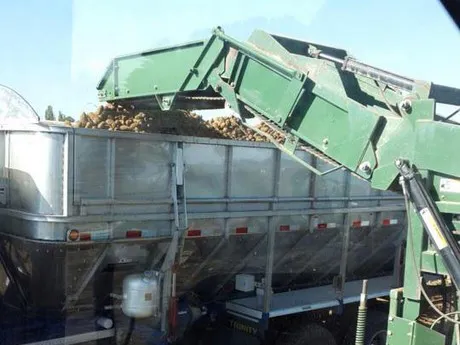After a lively start to the Idaho russet potato harvest, the market has fallen dramatically as supplies come on strongly. Prices have fallen by half since the start of August and growers are discounting to help move stock. Quality is excellent however, which has become both a blessing and a problem. There are so many top grade potatoes around that the sub grade supply is short, leaving shippers with no choice but to move some of the top grade potatoes into the sub grade category to help balance the market.
"We started our new Norkota crop on August 6," said Colin Gibson of 20/20 Produce Sales. "Since the start of the harvest season, prices have fallen from $14 to $7. Everyone is hitting the new Norkota crop hard and entering the market. We are running so hard as a state that all the coolers are full and there has been considerable discounting in order to move product."
"Quality though, has been excellent," he continued. "There has been such a high percentage of #1s that #2 grade product is harder to come by at the moment and therefore relatively pricey. As a result, we've had to slide some of the #1s into #2 in order to maintain a separation of the price points for the different grades."
Gibson noted that supplies of #2 grade will improve in a few weeks' time. "#2s will become more available when we start harvesting Burbanks. They were planted a bit later this year so they will be coming out a bit later, in three to four weeks."

Still warm but too early to predict yield
It's been a pretty warm summer in Idaho, but nothing that has caused any detrimental effects on the potato crop. As the harvest is now well underway, growers would prefer cooler temperatures which will optimize the quality, especially for the storage crop later on. "We prefer the ground to be cooler as the potatoes will be cooler out of the ground," Gibson explained. "The will result in fewer issues such as sweating in the box or mildew build up while in storage. Overall conditions are good though and we haven't experienced any problems related to immaturity or sizing. The profile looks to be fairly normal this year."
Gibson went on to share that observing what happens in Western Idaho is a good indicator of what will occur for Eastern Idaho, which is typically one or two weeks behind. "Yields might be off a little this year although it is still early to tell," he said. "The early digs on Norkota in Western Idaho are showing a nice size profile. This is usually pretty indicative of what we'll see in our Burbank crop."
Transportation situation improving
Some good news for potato growers is that the freight problems that are perpetually plaguing the industry seem to be easing. While prices are still higher than usual, it appears that truck drivers are getting used to the new E-Log legislation and have made the appropriate adjustments.
"Transportation seems to be getting better now," Gibson observed. "We are hearing less about the E-Logs and freight prices have come down again, although they are still above normal."
For more information:
Colin Gibson
20/20 Produce Sales
Tel: +1 (208) 677-2020
[email protected]
www.2020produce.com
